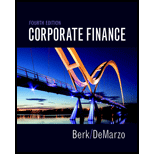
To determine: The expected return as per the
Introduction:
Capital asset pricing model (CAPM) describes the relationship between the projected return for assets and systematic risk on the stocks. It is utilized to compute the required
Expected return refers to a return that the investors expect on a risky investment in the future.
Beta is an important indicator of the risk of a security. It measures the systematic risk of a risky investment by comparing the risky investment with the average risky asset in the market.
Trending nowThis is a popular solution!

Chapter 11 Solutions
Corporate Finance Plus MyLab Finance with Pearson eText -- Access Card Package (4th Edition) (Berk, DeMarzo & Harford, The Corporate Finance Series)
- Boehm Incorporated is expected to pay a $3.20 per share dividend at the end of this year (i.e., D1 = $3.20). The dividend is expected to grow at a constant rate of 9% a year. The required rate of return on the stock, rs, is 15%. What is the estimated value per share of Boehm's stock? Do not round intermediate calculations. Round your answer to the nearest cent.arrow_forwardI have attatched two pictures that show DCF method. Here are the inputs: NOPAT growth: 10% ROIIC: 20% Cost of capital: 6.7%. Reinvement rate:50% Please show me how to calculate a residual value as shown in the picture.arrow_forwardAccording to the picture, It is a DCF method. But I'm not sure how they got the residual value of 1,642 in 1 year and so on. According to this, I don't know the terminal growth rate. Here are some inputs in the picture: NOPAT growth: 10%, ROIIC: 20%, Cost of capital: 6.7%, reinvestment rate: 10%/20% = 50%. Please Show how to get the exact residual value in the picture shown like first year, second year, third year, and so on.arrow_forward
- Could you please help to explain the DMAIC phases and how a researcher would use them to conduct a consulting for Circuit City collaped? What is an improve process performance and how the control improves process could help save Circuit City? How DMAIC could help Circuit city Leaders or consultants systematically improve business processes?.arrow_forwardWho Has the Money—The Democrat or The Republican? Ethical dilemma: Sunflower Manufacturing has applied for a $10 million working capital loan at The Democrat Federal Bank (known as The Democrat). But the person who is evaluating the loan application, Sheli, has determined that the bank should lend the company only $2 million. Sheli’s analysis of Sunflower suggests that the company does not have the financial strength to support the higher loan. However, if Sunflower is not granted the loan for the requested amount, the company might take its banking business to a competitor of The Democrat. Also, The Democrat is having financial difficulties that might result in future layoffs. Sheli might be affected by the bank’s layoffs if her division does not meet its quota of loans. As a result, it might be in her best interest to grant Sunflower the loan it requested even though her analysis suggests that such an action is not rational. Discussion questions: What is the ethical dilemma? Do you…arrow_forwardTASK DESCRIPTION This assignment is comprised of two discrete tasks that each align with one of the learning outcomes described above. One is an informal report based on a five-year evaluation of the financial management and performance of a London Stock Exchange (LSE) FTSE 100 listed company. This report relates to learning outcome one. The second task, covering learning outcome two, is an essay on a particular aspect of financial-decision making and the main issues and theoretical frameworks related to the topic. Task one (Informal business report) Students are required to choose a public listed company from a given list of familiar United Kingdom (UK) firms whose shares are traded on the London Stock Exchange's FTSE 100 index, download its most recent annual report(s) covering financial statements for the past five years, and from the data presented produce an informal report of approximately 3,000 words which includes a critical overall analysis of its financial performance over…arrow_forward
- Answer should be match in options. Many experts are giving incorrect answer they are using AI /Chatgpt that is generating wrong answer.arrow_forwardplease select correct option of option will not match please skip dont give wrong answe Answer should be match in options. Many experts are giving incorrect answer they are using AI /Chatgpt that is generating wrong answer. i will give unhelpful if answer will not match in option. dont use AI alsoarrow_forwardThe YTMs on benchmark one-year, two-year, and three-year annual pay bonds that are priced at par are listed in the table below. Bond Yield 1-year 2.39 2-year 3.11 3-year 3.52 What is the three-year spot rate for no-arbitrage pricing? Enter answer in percents.arrow_forward
- Answers for all the questionsarrow_forwardHello experts Answer should be match in options. Many experts are giving incorrect answer they are using AI /Chatgpt that is generating wrong answer. i will give unhelpful if answer will not match in option. dont use AI alsoarrow_forward3. Owen expects to receive $20,000 at the beginning of next year from a trust fund. If a bank loans money at an interest rate of 7.5%, how much money can he borrow from the bank based on this information? A. $12879.45 B. $12749.67 C. $15567.54 D. $174537.34arrow_forward
 Intermediate Financial Management (MindTap Course...FinanceISBN:9781337395083Author:Eugene F. Brigham, Phillip R. DavesPublisher:Cengage Learning
Intermediate Financial Management (MindTap Course...FinanceISBN:9781337395083Author:Eugene F. Brigham, Phillip R. DavesPublisher:Cengage Learning
 EBK CONTEMPORARY FINANCIAL MANAGEMENTFinanceISBN:9781337514835Author:MOYERPublisher:CENGAGE LEARNING - CONSIGNMENT
EBK CONTEMPORARY FINANCIAL MANAGEMENTFinanceISBN:9781337514835Author:MOYERPublisher:CENGAGE LEARNING - CONSIGNMENT



